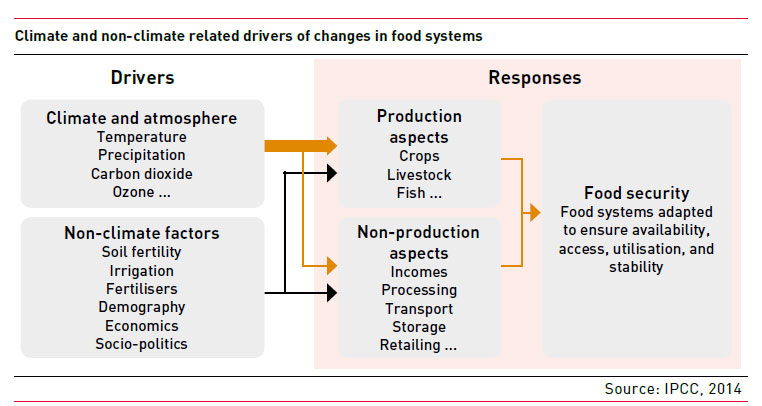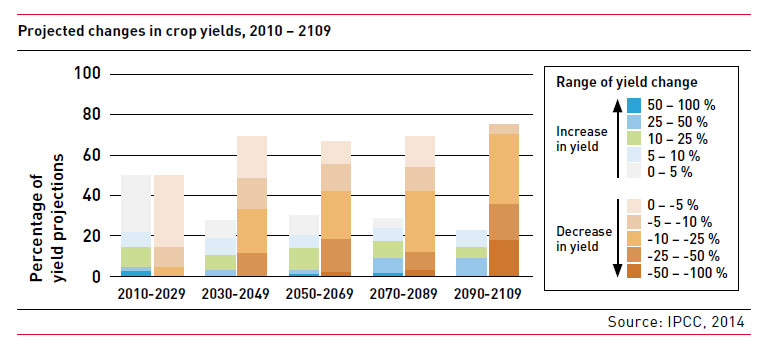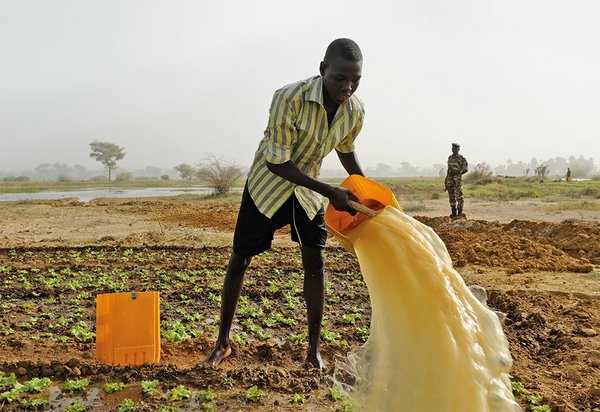 Download this article in magazine layout
Download this article in magazine layout
- Share this article
- Subscribe to our newsletter
Agriculture and climate change – where do we stand?
Agriculture has been one of the most complex topics in climate negotiations. It has all the features of a tricky problem: climate change affects agriculture in all parts of the world but with very different impacts; food security, livelihoods and trade are key sovereign interests that all parties seek to protect; agriculture policies are closely linked and affected by other international agreements particularly related to trade and subsidies; and agriculture is central to adaptation and mitigation but with a high degree of specificity, making standardisation and measurement difficult.
The United Nations Framework Convention on Climate Change (UNFCCC), signed by 197 nations, has protection of food security at its centre. Article 2 of the Convention states that its ultimate objective is to stabilise greenhouse gas concentrations in the atmosphere at a level that would prevent dangerous anthropogenic interference with the climate system, noting that “Such a level should be achieved within a time frame sufficient to allow ecosystems to adapt naturally to climate change, to ensure that food production is not threatened and to enable economic development to proceed in a sustainable manner” (UN, 1992).
Agriculture and agriculture-driven land use change contribute around 17 per cent of global greenhouse gas emissions. Agricultural production causes 70 per cent of the deforestation globally but also employs 70 to 80 per cent of the population in developing countries through smallholder farming. Many mitigation options, such as biofuels and re/afforestation, are intimately linked to agriculture.
Despite this significance, there has been little progress in the climate negotiations related to agriculture over the years. With the move to Nationally Determined Contributions (NDCs) to mitigate the factors causing climate change under the Paris Agreement, many countries now see the agriculture sector as central to their own climate strategies. But before delving into this, it is important to understand the factors and concerns that have impeded actions thus far.
Agriculture in the climate negotiations
Until fairly recently, climate negotiations have focused mainly on the mitigation potential of agriculture. They have been shaped by the ‘Common But Differentiated Responsibilities’ (CBDR), where mitigation responsibilities of nations are based on a combination of historical emissions, current capabilities to contribute to mitigation and development needs. In the negotiations, therefore, each country has tried to protect its key national interests, including agriculture, given its centrality in national food security, economy, trade and employment.
Large exporters of agricultural produce have been concerned about the potential impact of climate agreements on the competitiveness of their exports. Simulation studies on trade flow adjustments due to changing production and prices indicate that with climate change, growing populations and changing diets, agricultural imports of developing countries may double until 2050. Exporting nations fear that mitigation measures could become non-tariff trade barriers imposing restrictions on high emissions agricultural products. They fear for their patents and intellectual property rights when it comes to adaptation and related technology transfer.

Highly populated countries such as India are very anxious that food security of their populations is ensured. Sub-Saharan Africa and South Asia are two regions where agriculture is highly vulnerable to even small changes in temperature and rainfall. India has been emphasising the centrality of food security and resisting all efforts to include agriculture in mitigation actions.The African nations are also deeply concerned about food security and the climate vulnerability of their agriculture sector. They have however strongly advocated for a focus on the adaptation needs of the sector leading to this issue coming centre-stage in recent years. Several Latin American countries have supported mitigation measures in agriculture while also addressing adaptation and food security concerns. They have been the pioneers in developing Nationally Appropriate Mitigation Actions or NAMAs in the agriculture sector.
The different stakes in the agriculture sector also arise from differences within the sector regarding climate change impacts. A rising temperature will benefit agriculture in the mid-to-high latitudes, while agriculture in the low latitudes will be adversely affected even with small increases in temperatures. North America and the Russian Federation are likely to gain significant amounts of arable land thanks to global warming by 2080, while sub-Saharan Africa will lose a substantial amount (nine per cent) of its arable land.
Agriculture-related negotiations are further complicated by the fact that bioenergy and land-based mitigation measures, such as afforestation and reforestation, compete for land and that this trade-off is expected to intensify in the coming years. Rising demand for food and energy in turn leads to conversion of land for agriculture, causing further emissions. This is why the landscape approach is increasingly used to analyse the aggregated impacts across multiple sectors and sub-sectors. Total greenhouse gas emissions from livestock supply chains represent about 14 per cent of global emissions. It is clear that plant based diets have a lower carbon footprint, nevertheless this topic has remained a taboo in climate negotiations due to its impact on individual lifestyle choices.
Subsidies play an important role in agriculture. The Green Box subsidies in particular include environmental aspects, and planting low emission crops should ideally qualify for such subsidies. However, this is a highly contested domain, as current recipients seek to protect their interests.
What does science tell us?
The fifth Assessment Report of the Intergovernmental Panel on Climate Change (IPCC AR5) looked at agriculture as part of food systems, taking into account the impact of climate change on production as well as non-production aspects, such as processing, transport, storage and retailing.
The AR5 concluded that all aspects of food security are potentially affected by climate change, including food access, utilisation, and price stability. Effects of climate change on crop and terrestrial food production are already seen in several regions of the world. In the future, negative impacts will be more common than positive ones, and climate trends are also affecting the quantum and distribution of aquatic species. Large negative sensitivity of crop yields to extreme daytime temperatures is seen at around 30° C. While temperature trends are important for determining impacts on crop yields at sub-continental to global scales, at individual country or smaller scales, precipitation projections are important but have greater uncertainty for assessing future impacts.
Whereas enhanced CO2 levels in the atmosphere have a stimulatory effect on plants, in most cases, the damaging effects of elevated concentrations of tropospheric ozone (O3) are equally high on crop yields. Changes in climate and CO2 concentration will also enhance the distribution of invasive weeds. For the major crops (wheat, rice and maize) in tropical and temperate regions, climate change without adaptation will negatively impact production for local temperature increases of 2° C or more, although individual locations may benefit. Projected impacts vary across crops, regions, and adaptation scenarios.
Synthesising the results from over 1,000 modelling studies, the IPCC AR5 assessed that about 10 per cent of projections for the period 2030–2049 show yield gains of more than 10 per cent while another 10 per cent of projections show yield losses of more than 25 per cent, compared to the late 20th century. These include projections for different emission scenarios, for tropical and temperate regions, with and without adaptation. Relatively few studies have considered impacts on cropping systems for scenarios where global mean temperatures increase by 4° C or more. The IPCC graph on page 8 shows data for five timeframes in the near and long term, using data from 1,090 model projections for a 20-year period. The changes in crop yields are relative to late twentieth-century levels, and data for each timeframe add up to 100 per cent. The graph shows that while in the near term (2030) models show yield reduction and gains to an equal extent, in the longer term, the negative impacts are predominant.

In 2007, the IPCC’s fourth assessment report had concluded that the impacts of climate change would be particularly complex for groups with lower adaptive capacity, in particular smallholder and subsistence farmers, pastoralists and artisanal fisherfolk, typically located in the South. Developing countries are therefore understandably most concerned about their food security and their adaptive capacities.
The emissions from agriculture are much higher in developing countries and continue to rise, while they are declining in developed countries. Over the period of 2001–2011, annual emissions from developing countries increased by 14 per cent according to the UN Food and Agriculture Organization (FAO), while the emissions from agriculture in developed countries decreased by 3 per cent. Over the longer time horizon of 1990 to 2011, agriculture emissions increased by 37 per cent in developing countries and decreased by 20 per cent in developed countries. Asian countries account for 44 per cent of all agriculture emissions (ibid).
Agriculture and forestry are the sectors that can take atmospheric CO2 and convert it into carbohydrates and oxygen through photosynthesis. Increasing soil organic matter can be a significant sink, but there is considerable uncertainty about the carbon capture potential of different soils and its permanence (also see article "The role of soil carbon in mitigating climate change – lost cause or triple-win?"). Nevertheless, according to the UNFCCC, the global technical mitigation potential of agriculture (excluding fossil fuel offsets from biomass) is estimated to be 5.5 – 6 Gt CO2e (Carbon dioxide equivalent) per year by 2030. About 30 per cent of this potential can be achieved in developed countries and 70 per cent in developing countries.
Impact of the Paris Agreement
After the collapse of the climate negotiations at the Climate Summit in Copenhagen, Denmark, in 2009, where countries felt decisions were taken in a non-transparent, top-down manner, a concerted effort was made to re-think the architecture of the UNFCCC agreement. The 2015 Paris Agreement moves away from globally determined mitigation targets for countries to bottom-up nationally determined contributions (NDCs) to a global emission reduction goal. Each country is expected to indicate its own contribution to the global goal of keeping average global temperature increase ‘well below 2 degrees Celsius’ by 2100.
Agriculture now features in the NDCs and the national adaption plans of several countries (also see article "How to support countries to achieve their NDCs"), while the Paris Agreement itself has little reference to agriculture. About 90 per cent of the NDCs include adaptation and have agriculture as a priority sector for action, and about 80 per cent indicate their mitigation commitments in the agriculture sector. While this is a great turn-around many challenges still lie ahead – the NDCs provide few details about mitigation actions in the agriculture sector. Measurement and permanence of soil carbon sequestration is a challenge. Most NDCs have focused on the production aspects and not on the entire food system, where mitigation potentials are high. For example, only Rwanda has included reduction of food wastes, which accounts for about eight per cent of global greenhouse gas emissions, in its NDC. Some of the most effective mitigation measures, such as letting land lie fallow to regenerate, are not affordable by farmers in most countries, especially in developing countries where subsidies and other public investment in agriculture are lacking.
Concerns about the climate-induced risks to agriculture are driving collective global action. The Subsidiary Body for Scientific and Technological Advice (SBSTA) of the UNFCCC has identified four priority areas for further work:
- developing early warning systems in relation to extreme weather events;
- assessing risk and vulnerability of agricultural systems to different climate change scenarios;
- identifying agriculture adaptation measures;and
- identifying and assessing agricultural practices and technologies to enhance productivity sustainably.
Rapid progress on these topics is expected in the coming months leading up to the next meeting of the SBSTA in May 2018.
The way forward
The Marrakech Partnership for Global Climate Action is an initiative launched during COP 22 last year. It seeks to catalyse and support climate action by countries and other stakeholders during the important period of 2017–2020, when deep climate actions are needed. The Partnership’s priorities are co-operation between organisations, initiatives and coalitions, inter alia, on the interaction between climate action and the Sustainable Development Goals (SDGs). It promoted high-level engagement to help advance SDGs 2 (zero hunger) and 11 (sustainable cities and communities) at the recent COP 23 in Bonn, Germany, and will do so for SDGs 12 (responsible production and consumption), 8 (decent work and economic growth) and 9 (industry, innovation and infrastructure) at COP 24.
"The AR5 concluded that all aspects of food security are potentially affected by climate change."
A range of multi-stakeholder actions to address mitigation and adaptation needs in the agriculture sector are being implemented. They include private sector actors with large stakes in the sustainability of agriculture and food systems. While the negotiations for formally binding international regulations have been slow and painful, the shift towards voluntary commitments and carbon standards is important and can be a major driver of change, provided consumers reward the early adopters.
Rupa Mukerji is Co-head of Advisory Services at HELVETAS Swiss Intercooperation and a lead author for the 5th Assessment Report of the IPCC, working group II focusing on Vulnerability, Impacts and Adaptation. She has about 25 years of practical development experience and a background in natural sciences and management.
Contact: rupa.mukerji@helvetas.org
References and further reading
Fischer, G., H. van Velthuizen, M. Shah, and FO Nachergaele (2002): Global Agro-ecological Assessment for Agriculture in the 21st Century: Methodology and Results. Research Report RR-02-02.
Nelson, G., A. Palazzo, C. Ringler, T. Sulser and M. Batka (2009): The Role of International Trade in Climate Change Adaptation. ICTSD-IPC Platform on Climate Change, Agriculture and Trade, Issue Brief No. 4. Geneva: International Center for Trade and Sustainable Development and Washington DC: International Food & Agricultural Trade Policy Council.
World Resources Institute (2014): Greenhouse Gas Protocol Agricultural Guidance. Available at: www.ghgprotocol.org/agriculture-guidance





Add a comment
Be the First to Comment